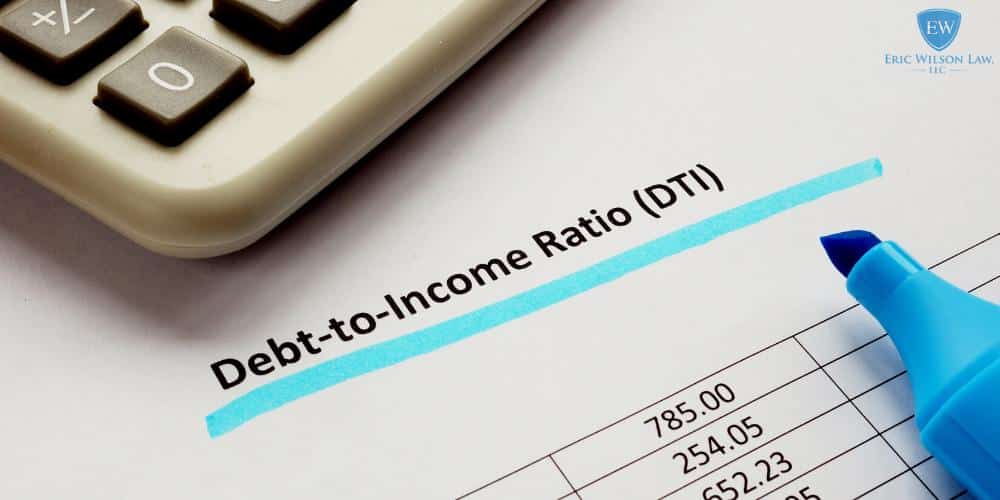Terms like credit utilization ratio and debt to income ratio may sound fancy, but all these ratios really do is give lenders an idea of how much debt you have on a monthly basis. Lenders generally look at these ratios to determine whether or not you’re a reliable borrower and whether or not you can manage your monthly bills comfortably. But if you’re considering buying a house, you may be wondering: what’s a good debt to income ratio for a mortgage? Below, the legal team at Eric Wilson Law answers this question and so much more.
If you’re drowning in debt, now is probably not the time to take on a mortgage. But becoming financially stable enough to buy a house is a great personal goal to have in mind. Eric Wilson can help you turn your financial situation around so that you can not only buy a house, but live comfortably in it too. For more information on how Eric Wilson can help you achieve a debt free life, call 205-349-1280 today.
What is the Debt to Income Ratio (DTI)?
The DTI ratio is the percentage of your monthly gross income (AKA: your pre tax monthly income) that goes towards your monthly debt obligations like credit card bills, medical bills, student loan debt, tax debt, etc. In other words, the infamous debt to income ratio compares someone’s total monthly debt payments to their total monthly income.
Debt to income ratios give lenders insight into how reliable a borrower may be. A lower DTI ratio – usually below 36% – indicates that a borrower is reliable and that they have their debt under control. Someone with a low DTI ratio will have an easier time obtaining personal loans and auto loans from lenders. Meanwhile, a higher DTI ratio indicates that a borrower may not be reliable and that they are struggling to control their debt balances. People with higher DTI ratios will struggle to obtain conventional loans.
For example, a low DTI ratio of 15% means that someone is putting 15% of their gross monthly income towards monthly debt payments. Conversely, when someone with a high DTI ratio of 36% or higher, this means that they are putting more than 36% of their gross monthly income towards monthly debts.
How to Calculate Debt to Income Ratio
This is the formula for DTI calculation: divide your total monthly debt payments by your total monthly gross income. The resulting percentage is your debt to income ratio. You don’t have to include your normal monthly expenses – like groceries, utilities, health insurance, gas, hygiene products, etc. – when calculating your debt to income ratio.

What is a Good Debt to Income Ratio for a Mortgage?
Most lenders prefer a debt to income ratio below 36%. But the highest ratio that you can have to get qualified for a mortgage loan is 43%. In order to buy a house and live as comfortably as possible, you want less than 28% of your gross monthly income going towards a monthly mortgage payment. The money that goes towards monthly mortgage payments – divided by monthly income – is your front end ratio. We will explain front end vs. back end ratios shortly.
Just because you can have up to a 43% DTI ratio in order to buy a house doesn’t mean that you should have a DTI ratio that high. While you will still qualify for a mortgage application and loan, you probably won’t get the best home and mortgage interest rate. Additionally, once you’re in that home, you may struggle even more than you already are to keep up with your monthly debt payments and housing related expenses because of your high DTI ratio. As a general rule of thumb, you should try to lower your DTI ratio as much as possible before buying a house.
Front End Ratio
It’s important to know about front end ratios and back end ratios before going through the mortgage process. A front end ratio is all of your monthly housing expenses (monthly mortgage payment, home insurance, property taxes, HOA fees, etc.) divided by your gross monthly income.
Back End Ratio
Meanwhile, your back end ratio includes all your other monthly expenses and debts (auto loans, credit card debt, student loan debt, tax debt, etc.) divided by your monthly gross income. It is normal for back end ratios to be much higher than front end ratios.
Potential homeowners should shoot for around 28% for their front end ratio and below 36% for their back end ratio. Additionally, it’s important to know that most lenders focus on the back end ratio percentage compared to the front end ratio, especially when it comes to conventional loans not backed by the federal government. But if you’re trying to qualify for a FHA loan, lenders will likely put equal weight in both ratios.
How to Improve Your Debt to Income Ratio
Buying a house is a big decision that requires you to be as financially stable as possible. You don’t want to buy a home and realize once you move in that you’re going to struggle to not only pay down your existing debt, but to also pay for other things like food, gas, entertainment, utilities, phones, and even child support, for example. So, how do you lower your debt to income ratio?
Pay Off Debt
The most obvious way to lower your DTI ratio is to steadily pay down your existing debt, but this is way easier said than done. Here are some debt relief methods you can consider:
- If you can afford it, pay more than minimum payments on your debts.
- Try to pay off the debt with the highest monthly payments and highest interest rates first.
- Think about restructuring your loans so that you can get lower interest rates.
- If you have too much credit card debt, consider debt relief methods like credit card refinancing and debt consolidation.
- Negotiate your debt with your creditor.
- If you have way too much debt in general, consider filing for Chapter 7 bankruptcy or Chapter 13 bankruptcy.
Increase Your Income
Increasing your income is also way easier said than done. You may be able to ask your boss for more money especially if you have been at your company for a significant amount of time, you have taken on more responsibilities lately, or you’re just an overall good employee.
If this isn’t an option, you can look around for higher paying jobs or you can take on a side hustle. Many people find that working for Uber, Lyft, Doordash, and Postmates for a few hours every day can provide more money to pay off their debts quicker. Or you could even lean into your creative hobbies and sell things like art, crocheted items, stickers, keychains, earrings, etc.
Don’t Take on Any More Debt
Lastly, don’t take on any more debt while you’re desperately trying to pay off your other debts. Again, this may be easier said than done. In life, there is always something to pay for. Medical emergencies, car repairs, and broken dishwashers seem to pop up out of nowhere, especially while you’re struggling to keep up with other monthly payments. But one of the best ways to avoid taking on more debt for the time being is to avoid using credit cards for big purchases.

Call a Tuscaloosa Bankruptcy Lawyer at Eric Wilson Law Today
Your debt to income ratio is definitely not the only thing that will determine overall home affordability, but still, this ratio can give you and your lender significant insight into your current financial situation. If you’re struggling to make ends meet due to recurring debt, it’s okay to reach out for professional help. Eric Wilson has been helping his clients achieve comfortable, debt free lives for more than 25 years. Call 205-349-1280 to schedule a free consultation today.


